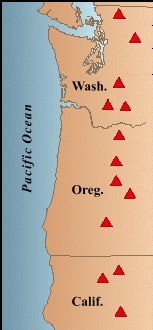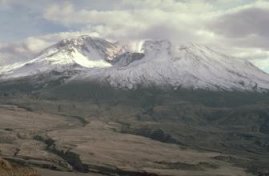
June Editorial
The volcanoes of the Cascade mountain range

June Editorial
The volcanoes of the Cascade mountain range
|
This vast mountain range stretches down the west side of North America from southern Canada through the states of Washington and Oregon into Northern California. The Cascade mountains not only shape the landscape and geology of western North America but also have a considerable impact on the climate.
|
The Cascades are part of the Pacific Ring of Fire (often just referred to as the Ring of Fire); a 400,000 km area around the basin of the Pacific Ocean which is a near-continuous series of volcanic belts and oceanic trenches with active tectonic plates. The Ring of Fire, with its 452 volcanoes, has approximately 75% of the world's active and dormant volcanoes. (Dormant volcanoes are those which have not been active for a long time, but are still not fully extinct.) | |
|
There are 18 volcanoes in the Cascade range and most of them have been active in the past 2000 years. Of the most active, seven have had some volcanic activity reported in the last 200 years. In fact all recent volcanic eruptions in the USA outside Hawaii and Alaska have been from Cascades volcanoes.
By far the most active and best known of the Cascades volcanoes is Mount St Helens - a stratovolcano in Washington state. The most recent eruption was in 1980 - a major eruption classified as VEI 5. The VEI is the Volcanic Explosivity Index. This classifies volcanoes by volume of products, eruption cloud height, and qualitative observations to determine the scale. So, for example, Stromboli in the Mediterranean has continuous but relatively gentle eruptions, and its activity is classified as VEI 2. A VEI 5 eruption is also called a Plinian Eruption - an eruption of similar strength to the eruption of Mt Vesuvius in 70 AD which destroyed Pompeii. When Mount St Helens erupted on May 18 1980, it literately blew its top off. The eruption was preceded by a series of earthquakes and steam-venting episodes. These were caused by an injection of magma at a shallow depth below the volcano that created a huge bulge on the north slope of the mountain. On the day of eruption, the weakened north slope collapsed and slid down exposing the partly molten lava, gas and hot rocks. The rock responded by exploding a hot mix of lava and pulverized older rock. The subsequent eruption column rose 2.4 km into the atmosphere and deposited ash in 11 U.S. states. Minor eruptions of Mount St. Helens have occurred since, most recently in 2006. 
The mountain is now closely watched for further activity. You can join the watchers on a live webcam: Mount St. Helens volcanocam. The picture on the right was captured from the 'volcanocam' on one of the few days when it was not raining or foggy. The weather is a major problem for observers of Mount St Helens. The yearly precipitation is 100 inches of rain, partly caused by the Cascade mountains themselves, as the mountains intercept warm, wet air currents from the Pacific and cause them to drop the moisture as precipitation on the western slopes. At the same time the mountains create a rain-shadow effect where the average annual rainfall drops from as much as 150 inches in some areas to as low as 9 inches. The only other volcano in the Cascade range which erupted in the 20th century was Lassen Peak (also referred to as Mount Lassen). Lassen Peak is the southernmost active volcano in the Cascade Range. It is also the largest lava dome on Earth with a volume of half a cubic mile. The major Lassen eruption occurred on May 22 1915 with a powerful explosion which devastated the area. The volcano remained active for six years with sporadic smaller eruptions. Other two volcanoes worth mentioning here are the Mount Rainier and Mount Baker. Mount Rainier, about 87 km south of Seattle is the highest mountain in the Cascade Range at 4392 meters. It is an active stratovolcano, although the last recorded eruptions were between 1820 and 1854. As from 2007 there has been no evidence of imminent eruption, but Mount Rainier is classified as a Decade Volcano - one of sixteen volcanoes in the world which have been put into this group. If any of these erupt, huge loss of life and property will result. Finally Mount Baker, just south of the Canadian border, is the second most active volcano in the Cascade range after Mount St Helens. The present cone of Mount Baker is relatively young and actually sits atop another volcanic cone called Black Buttes Volcano which was active around 300,000 years ago. Mount Baker is famous for its glaciers and large volume of snow. After Mount Rainier, Mount Baker is the most heavily glaciated of the Cascade volcanoes. The volume of snow and ice on Mount Baker is greater than all the other Cascade volcanoes (excluding Rainier) combined. It is also one of the snowiest places in the world. In 1999 the Ski resort on Mount Baker recorded a record snowfall from a single season of 28 meters. The Cascades are subdivided into the Southwestern range, which is everything south of Mount Rainier; the North Cascades (north of Mount Rainier), and the Cascade Mountains north of the Canada-USA border. The North Cascades and the Southwestern Canadian Cascades are very rugged, with many steep and glaciated lesser peaks. On the other hand the Northern Canadian Cascades and the north-eastern mountains are less glaciated and more plateau-like, resembling nearby areas of the Thomson Plateau. | |
| _______________________________ | ||||
| Home | | | Shopping | | | Database |
© Biscuit Software 2004-2015
All rights reserved